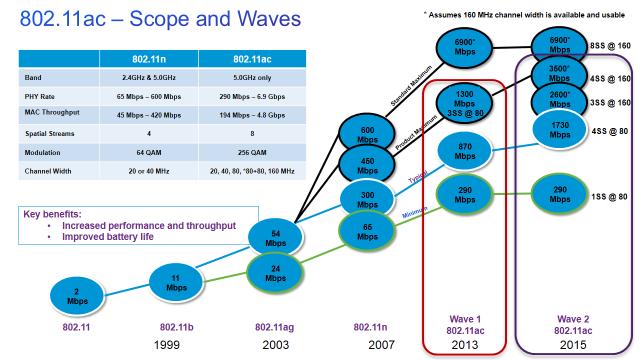Wi-Fi standards, the development of which is managed and ratified by the IEEE (Institute of Electrical and Electronics Engineers) have changed significantly over the years. From 802.11-1997, the first “official” Wi-Fi protocol, to the most recent release, 802.11ac, Wi-Fi technology has enabled networks to become faster and more reliable with each successive release.
Over the course of that journey, the IEEE has ratified eight protocols. Some marked minor changes; others represented substantial speed and performance upgrades. During that time, the science behind Wi-Fi transmission standards has remained arcane, at best, to the majority of its users. From business owners to company staff, everyone simply wants Wi-Fi to operate reliably and quickly.
In early 2014, the IEEE released the 802.11ac standard, and manufacturers are now touting its superiority in their marketing materials. The question for business decision makers is not, “How does this new Wi-Fi protocol work?” but rather, “What are the bottom line benefits of 802.11ac, and should I budget for an upgrade?”
The most noticeable change, comparing 802.11ac with its predecessors, is speed. Network protocol speeds have always been stated at the maximum possible data rate in perfect conditions. These speeds also represent the maximum total amount of “throughput,”—bandwidth everyone can share.
Even so, 802.11ac is impressive. With a maximum data rate as high as 1 Gigabit per second (Gbit/s), it is 500-1000 times faster than 802.11-1997. It is nearly twice as fast as that of its immediate predecessor, 802.11n, which offers data rates of up to 600 Mbits/s, with total bandwidth for the connected user base network a bit lower. Furthermore, the standard specifies data rates of up to 500 Mbits/s for an individual connection; something that the world hasn’t seen before in an 802.11 connection.
Equally importantly, 802.11ac incorporates a method for waveform manipulation (modulation) to create support for denser networks than its predecessors—more users on a single access point. It also has lower energy requirements, making battery-driven or Power over Ethernet access points a very practical reality.
The technologies that underlie all this wizardry aren’t important, although you can certainly read about them at the IEEE site, if you wish. The key takeaway is that with 802.11ac, your networks will be faster, you’ll be able to service more users with fewer access points, and you’ll have options for a redundant energy supply.
802.11ac doesn’t have quite the range of 802.11n, so at the present we recommend enterprises remain with 802.11n unless their networks are indoors or on small campus environments. For busy organizational environments where companies want to squeeze the most connectivity out of the fewest access points, however, we endorse it enthusiastically.

LMI works with a number of companies that have developed cutting-edge 802.11ac equipment. One of them is this month’s featured vendor, Aruba Networks. We also recommend and install access points and related networking equipment from other leading providers such as Cisco, Aerohive and Fortinet. To discuss the value of 802.11ac or explore its potential for your next network installation or upgrade project, please give us a call at (770) 491-0343 or send an email to j.taylor@lmisystemsinc.com.
